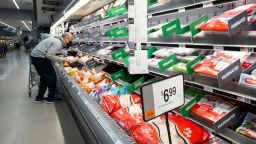Prices kept rising in February as another key inflation gauge soared and hit double digits.
The US producer price index, which tracks what America’s producers get paid for their goods and services on average over time, rose 10% for the 12-month period ended in February, not adjusted for seasonal swings, according to the Bureau of Labor Statistics.
That was a slightly faster pace of price increases than economists had predicted.
For January, 12-month price inflation was also revised up to 10%, from the 9.7% initially reported, the first time the index hit double digits since the data series began in 2010.
Over the one-month time span, producer prices rose 0.8% in February, adjusted for seasonality, slightly less than forecast and below the January level.
Where did prices rise?
Most of the February price increase came on the back of higher energy costs. Global oil prices spiked at the end of February as Russia invaded Ukraine. Since the start of the year, US oil prices have risen nearly 30%.
Nearly 40% of the February price increase for finished products were due to higher gas prices, for example. Outside of energy, cars and trucks and dairy products also got more expensive.
Prices for products sold to other businesses, such as parts, also rose – mostly due to energy costs.
Thus, stripping out energy costs paints a much more restrained picture of producer price inflation.
Without energy, food and trade services, PPI rose a modest 0.2% in February – markedly less than in January and the lowest level since November 2020 – and 6.6% over the 12-month period, also a decrease from the start of the year.
That said, the energy price crunch won’t go away any time soon, as the geopolitical situation isn’t showing any signs of letting up.
That means elevated energy costs for longer, which will lead to rising food prices.
“The conflict in Ukraine is expected to hit food prices globally through the spring, as Russia and Ukraine combine to account for 14% of wheat production and 30% of global exports,” said PNC economist Kurt Rankin.
Meanwhile, America is still dealing with supply chain issues.
“This supply and demand imbalance will also continue to put upward pressure on food prices for producers, and thus US households, in the coming months,” Rankin said.






















